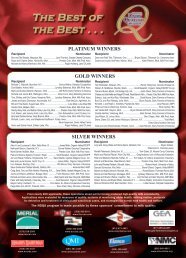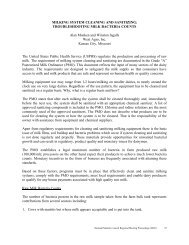DECIDING TO DRY,OFF - National Mastitis Council
DECIDING TO DRY,OFF - National Mastitis Council
DECIDING TO DRY,OFF - National Mastitis Council
Create successful ePaper yourself
Turn your PDF publications into a flip-book with our unique Google optimized e-Paper software.
It is disappointing that large-scale surveys of the industry have failed to capture these data. In<br />
1996, the USDA released the <strong>National</strong> Animal Health Monitoring System (NAHMS) dairy<br />
survey (15). This was a major effort to document common management practices on dairy<br />
farms across the United States. However, as comprehensive as this initiative was, it did not<br />
describe how cows are commonly dried off at the end of lactation.<br />
Association Between Milk Yield at Drying Off and <strong>Mastitis</strong><br />
The method used to end lactation has been driven by the underlying principle that less milk in<br />
the udder will result in fewer infections. This has been demonstrated when milk production has<br />
been reduced through intermittent milking (27). It remains to be determined if there is an<br />
optimal level of production at which cows should be dried off.<br />
One of the preliminary studies to investigate this question was carried out in 1956 (22),<br />
subsequent to the first report that there was a difference in new IMI between different methods<br />
of drying off. Over a four year period, 113 cow-dry periods were examined in a herd with<br />
approximately 20% of cows producing 20 lbs of milk around the time of drying off. There was<br />
a significant difference in the incidence of mastitis when cows were stratified based on<br />
production, while controlling for age. When production at drying off was less than 7 pounds of<br />
milk, 41.7% of cows (18.4% of quarters) became infected during the dry period. By<br />
comparison, 71.4% of cows (43.4% of quarters) producing greater than 21 pounds of milk<br />
developed new infections. There was no association between yield at drying off and milk<br />
production in the subsequent lactation (21). Analysis of the data stratified on the basis of<br />
production allowed the investigators to conclude that once milk production has decreased to 10<br />
lbs, it appears safe to end milking abruptly. However, it was suggested that it might be safe to<br />
abruptly end lactation at higher levels with proper teat end sanitation.<br />
An investigation of the effect of drying off practices on mastitis infection was conducted in the<br />
early 1970’s in New York dairy herds (18). Comment was made about the importance of the<br />
level of production at drying off, while the study also confirmed the importance of dry period<br />
length and dry cow antibiotic therapy. The new infection rate ranged from 8-18% of quarters.<br />
The level of milk production at drying off had no significant effect on the rate of new IMI.<br />
However, cows with lower production at drying off were more likely to be found infected<br />
immediately before drying off. Intermittent cessation of milking was concluded to be the better<br />
technique to end lactation when dry cow antibiotic therapy was not used. The effect of method<br />
of drying off on new infection rate was decreased when dry cow antibiotic therapy was used. It<br />
was suggested that the number one management factor that can be easily manipulated to alter<br />
the number of quarters becoming infected during the dry period is the use of dry cow antibiotic<br />
therapy. This may still be the best advice available to producers today. That is, as the<br />
importance of various management factors continues to be investigated and manipulated to<br />
improve the success of the dry period, the benefit of practices such as dry cow antibiotic<br />
therapy and post milking teat disinfection cannot be neglected.<br />
There continue to be conflicting reports on the overall effect of milk yield prior to drying off<br />
on the risk of infection. One specific level of production has not been cited as optimal.<br />
72 <strong>National</strong> <strong>Mastitis</strong> <strong>Council</strong> Annual Meeting Proceedings (2001)





